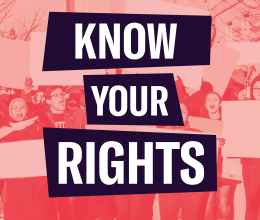Derby, Kansas, high school sophomore Jonathan Villarreal was walking to the bus after school when a police officer ordered him to pull his pants up above his hips. Jonathan refused, on the grounds that the school day was over. As reported in the Wichita Eagle, here’s what happened next:
[Villarreal] said one of the officers, a man who was larger than him, pulled him to the ground by the neck and told him to stop resisting arrest. Villarreal denied he was resisting.
Both officers kneed him in the back and neck while he was on the ground, he said.
Because they were physical with him, he struggled to get up, but was pushed back down, he said.
At one point as he tried to get up, Villarreal said he felt his arm break when he was pushed back down.
After Villarreal tried three times to get up, one officer fired a Taser at his chest, he said. Although he was wearing a heavy coat, he still felt an electrical shock, he said.
According to the article, the police department is investigating the incident. But, sadly, it illustrates a larger problem that continues to pop up around the country: the use of street-policing tactics against kids, and disproportionately kids of color, for behavior that, at worst, might merit ordinary school-based discipline.
Around the country, police assigned to patrol school campuses — where police may have a legitimate role in responding to serious criminal conduct or imminent danger — often direct their efforts where law enforcement is clearly misplaced. This is part of a disturbing national trend called the School-to-Prison Pipeline, wherein children are funneled out of public schools and into the juvenile and criminal justice systems. Jonathan’s story is a perfect example of this larger problem. A school’s right to regulate dress code is one thing; but whatever role such regulations play in a school’s educational mission, they fall miles short of justifying a police officer’s use of brutal force against a kid.
Every child deserves an educational experience free from inappropriate policing. Over and over again, however, a pattern emerges: students of color are most likely to face overaggressive policing in schools and to suffer long-lasting effects on their educational prospects as a result. Being arrested nearly doubles the odds that a child will drop out of school, and, if coupled with a court appearance, nearly quadruples the odds of dropout; an arrest also lowers standardized test scores, reduces future employment prospects, and increases the likelihood of future interaction with the criminal justice system.
The ACLU is engaged in nationwide advocacy against over-policing in the classroom. One aspect of that advocacy is a case we filed with the New York Civil Liberties Union and the law firm Dorsey & Whitney challenging the manner in which New York Police Department officers are deployed in public middle and high schools in New York City. Following years of investigation and advocacy, the lawsuit argues that a pattern of unlawful arrests, seizures, and uses of force violate the constitutional rights of students throughout New York City.
Jonathan’s story has disturbing echoes in our lawsuit: In New York City, kids are routinely arrested and subjected to force for behavior that arguably violates school rules but falls far short of criminal conduct. The litigation tells several of these stories. One 12-year-old girl was handcuffed and arrested for drawing on a desk in erasable marker. Another student — a 15-year-old girl — was painfully handcuffed and arrested for not proceeding quickly enough to detention.
Our lawsuit is pending. We hope that it will lead to meaningful reforms in New York City. Beyond the immediate ruling we seek from the court, we hope it has a broader impact as well. Eventually, policing in the school environment should be limited to only the most extreme circumstances. But the realm of ordinary school discipline should belong to educators, not cops.
(Originally posted on the Blog of Rights.)




